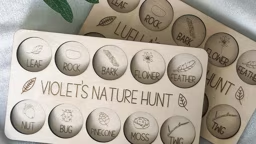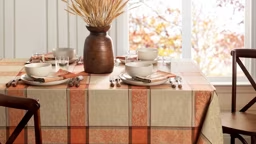
Photo Credit: Raj Chaudhry
Keep track of comings and goings – or add to the grocery list – with this handy message board that would look at home in any cabin with a northwoods theme.
You can easily make it in a weekend with a router table, rabbeting bit and pocket-hole jig. If you don’t have all the tools needed, they can be added to your collection at a reasonable cost.
The secret behind this project’s magnetic personality is a blackboard of porcelain-coated steel.
Any light-colored hardwood will work for the frame. For a rustic look, pick boards with character: small knots, worm holes, interesting grain or colorful patterns. All the wood for the frame is 3/4-inch-thick – the most common size for hardwood lumber.
The loon silhouette is cut from 1/4-inch birch plywood. A blackboard panel behind the cutout adds contrast. Plywood also backs the chalkboard, to add sturdiness. All of these panels are held in a recess (rabbet) routed into the back of the frame. (Imagine a photo frame.)
The frame itself is fastened together with pocket-hole screws. They are bored at angles through the backs of the horizontal members, or rails, into the vertical pieces, or stiles. These screwed joints are as strong as they are simple to execute.
The finished dimensions are 14 1/2 inches wide and 20 1/2 inches long.
You can easily make it in a weekend with a router table, rabbeting bit and pocket-hole jig. If you don’t have all the tools needed, they can be added to your collection at a reasonable cost.
The secret behind this project’s magnetic personality is a blackboard of porcelain-coated steel.
Any light-colored hardwood will work for the frame. For a rustic look, pick boards with character: small knots, worm holes, interesting grain or colorful patterns. All the wood for the frame is 3/4-inch-thick – the most common size for hardwood lumber.
The loon silhouette is cut from 1/4-inch birch plywood. A blackboard panel behind the cutout adds contrast. Plywood also backs the chalkboard, to add sturdiness. All of these panels are held in a recess (rabbet) routed into the back of the frame. (Imagine a photo frame.)
The frame itself is fastened together with pocket-hole screws. They are bored at angles through the backs of the horizontal members, or rails, into the vertical pieces, or stiles. These screwed joints are as strong as they are simple to execute.
The finished dimensions are 14 1/2 inches wide and 20 1/2 inches long.
Materials
- frame: 3/4" hardwood cut to 11/2" x 201/2" (2 pieces) and 11/2" x 111/2" (3 pieces)
- two pieces 1/4" birch plywood, one 12" square and one 12" x 5"
- black metal chalkboard, cut to same sizes
- yellow wood glue
- polyurethane or polyacrylic finish
- 1 1/4" No. 7 screws, for pocket joinery
- sandpaper
- brads or picture points
- hanging hardware
- 1/4" round black magnet
Tools
- table saw
- router with table
- router bits: rabbeting, 3/8" round nose bit
- pocket-hole jig with stepped drill bit
- clamps
- combination square and tape measure
- scroll or coping saw
- corner or bench chisel
- tin snips
- sander
- hand drill/driver & bits

Message Board Diagram
Instructions
1. Rout rabbets (recesses) in frame.
Cut a 1/4" wide, 3/8" deep recess on the back inside edge of the top and bottom horizontal frame pieces, and both back edges of the middle horizontal piece.

2. Drill pocket holes.
A pocket-hole jig allows you to drill precisely angled holes in the horizontal pieces. These holes will house the screws that fasten the frame together.
Determine where to drill the pocket holes, and mark the centers of these holes on the back of each piece, one pair per end. For the top and bottom horizontal pieces, mark the center for one hole 1 1/32" from the top edge and the other the same distance from the bottom edge.
The space is tighter on the center piece, which has a recess on each edge. Here, mark the center of each hole 9/32" from its closest edge, top or bottom.
Drilling the holes is straightforward. The most common brand of pocket-hole jig comes with a stepped drill bit, which has a stop collar that controls the depth. For 3/4" thick stock, set the collar 3 1/2" from the step of the bit. After this, you simply line up the index mark on your work piece with an index line on the jig, clamp; and drill until the stop collar hits the jig. Continue in this fashion until all your holes are drilled – 12 in all.
Determine where to drill the pocket holes, and mark the centers of these holes on the back of each piece, one pair per end. For the top and bottom horizontal pieces, mark the center for one hole 1 1/32" from the top edge and the other the same distance from the bottom edge.
The space is tighter on the center piece, which has a recess on each edge. Here, mark the center of each hole 9/32" from its closest edge, top or bottom.
Drilling the holes is straightforward. The most common brand of pocket-hole jig comes with a stepped drill bit, which has a stop collar that controls the depth. For 3/4" thick stock, set the collar 3 1/2" from the step of the bit. After this, you simply line up the index mark on your work piece with an index line on the jig, clamp; and drill until the stop collar hits the jig. Continue in this fashion until all your holes are drilled – 12 in all.

3. Assemble frame.
Assemble the frame by screwing the top and bottom horizontal pieces to the vertical frame pieces. Clamp the frame pieces so that their faces are flush and their edges aligned. Don’t tighten the screws all the way.
Use screws made for pocket-hole joinery. They are self-tapping, withstand heavy torque and have wide heads to spread the clamping pressure. The right screws for this job are 1 1/4" long with fine threads and square-drive, washer-style heads.
After both top and bottom frame pieces are attached, and the frame checked for square, position the middle horizontal piece so that it is centered 6 3/4" from the top edge of the frame. Clamp the piece in place, and fasten with same No. 7 screws.
Use screws made for pocket-hole joinery. They are self-tapping, withstand heavy torque and have wide heads to spread the clamping pressure. The right screws for this job are 1 1/4" long with fine threads and square-drive, washer-style heads.
After both top and bottom frame pieces are attached, and the frame checked for square, position the middle horizontal piece so that it is centered 6 3/4" from the top edge of the frame. Clamp the piece in place, and fasten with same No. 7 screws.

4. Cut recesses on vertical pieces.
With the frame assembled, cut recesses in the vertical frame pieces to match those in the horizontal pieces. Use a bearing-guided rabbeting bit in a handheld router. The bit will leave curved corners, so to square these, remove the waste with a corner chisel.
5. Disassemble and route chalk groove.
Disassemble the frame. Set up your router table to cut a chalk groove in the top edge of your bottom frame piece with a 3/8" diameter round-nose bit to cut a 1/8" deep channel.6. Glue and re-assemble frame.
Brush a small amount of yellow wood glue on each mating surface and screw the frame back together. Use a damp rag to wipe off any squeeze-out.
7. Measure and cut panels.
Using your assembled frame, measure for the plywood and chalkboard panels. Cut the panels about 1/8" smaller than the recesses they will fit into.
For metal chalkboard, mark your cut lines on the back, and shear along these lines with a pair of tin snips. Wear gloves to prevent cuts, and grind or file down any sharp edges.
For metal chalkboard, mark your cut lines on the back, and shear along these lines with a pair of tin snips. Wear gloves to prevent cuts, and grind or file down any sharp edges.

8. Cut the loon silhouette.
Find a simple loon pattern online. Transfer the pattern onto your plywood, drill a starter hole for your saw blade and follow the pattern with a scroll or coping saw.After cutting, you can smooth and refine your cuts with a small, curved rasp or with sandpaper.
9. Prepare the frame and panels.
Sand all wooden parts and surfaces with the grain. A palm or random-orbit finish sander makes the work go more quickly.
Make sure your surface is dust-free. Then, brush on a semi-gloss polyurethane or polyacrylic finish. Apply three coats, with fine sanding between each. Also coat the backs of the steel chalkboard panel.
After the parts have been sanded and finished, affix the panels in the frames with brads or picture points.
Make sure your surface is dust-free. Then, brush on a semi-gloss polyurethane or polyacrylic finish. Apply three coats, with fine sanding between each. Also coat the backs of the steel chalkboard panel.
After the parts have been sanded and finished, affix the panels in the frames with brads or picture points.

10. Finishing touches.
Install the hanging hardware, centered at the tops of the vertical frame pieces.
As a final touch, make an eye for the loon by painting a 1/4" diameter rare-earth magnet red.
As a final touch, make an eye for the loon by painting a 1/4" diameter rare-earth magnet red.
See also How to Store Your Tools for Winter
Raj Chaudhry claims no rabbets were harmed in the making of this project.










